Discover 11 hidden attractions, cool sights, and unusual things to do in Brooksville (United States). Don't miss out on these must-see attractions: Hernando Park, May-Stringer House, and Chinsegut Hill Manor House. Also, be sure to include Weeks Hardware in your itinerary.
Below, you can find the list of the most amazing places you should visit in Brooksville (Florida).
Table of Contents
Hernando Park

The Hernando County Courthouse, built in 1913, is an historic courthouse building located in Brooksville, Florida, It was designed by Atlanta-based architect William Augustus Edwards who designed one other courthouse in Florida, two in Georgia and nine in South Carolina as well as academic buildings at 12 institutions in Florida, Georgia and South Carolina. He designed most of the original buildings on the campus of the University of Florida in Gainesville.
The courthouse been called the Brooksville crown. In 1989, The Hernando County Courthouse was listed in A Guide to Florida's Historic Architecture, published by the University of Florida Press.[1]
Address: 205 E Fort Dade Ave, Brooksville
May-Stringer House
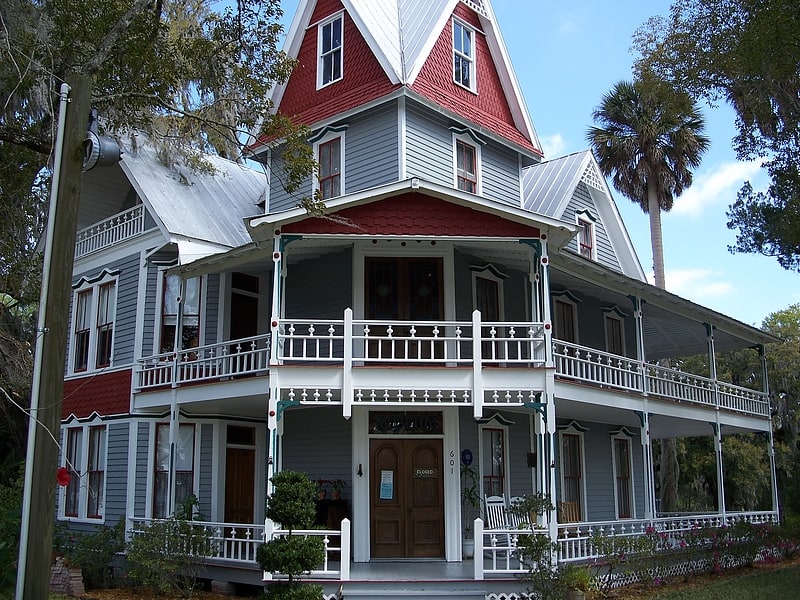
Museum in Brooksville, Florida. The May-Stringer House, home of the Hernando Heritage Museum, is a historic residential building in Brooksville, Florida, United States. It is located at 601 Museum Court. On March 8, 1997, it was added to the National Register of Historic Places.
Overlooking the City of Brooksville, the house is a 4-story, seven gable, gingerbread trim, 14 room “Painted Lady” Victorian era home. The Hernando Historical Museum Association has created exhibit rooms with a Victorian Look, and there are rooms devoted to specific themes such as an Elegant Dining Room, Victorian Bedrooms, Military Room, an 1880s Doctor's Office, and a 1900s Communication Room. The museum contains over 10,000 artifacts that can be viewed.[2]
Chinsegut Hill Manor House
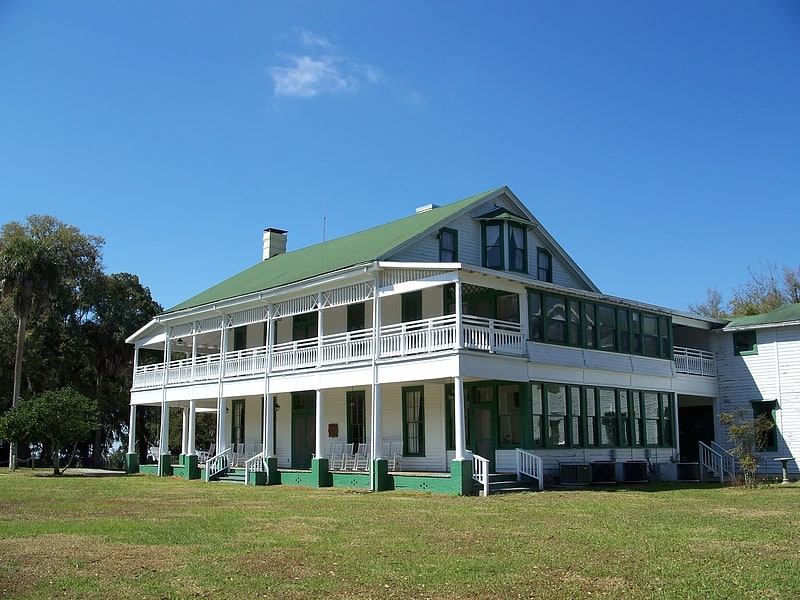
Historical place museum in Hernando County, Florida. The Chinsegut Hill Manor House is a United States historic site approximately five miles northeast of the city of Brooksville, Florida on Chinsegut Hill. It is located at 22495 Chinsegut Hill Road. Begun in the early 1850s, the structure has remained relatively unchanged since.[3]
Address: 22495 Chinsegut Hill Rd, 34601-4642 Brooksville
Weeks Hardware
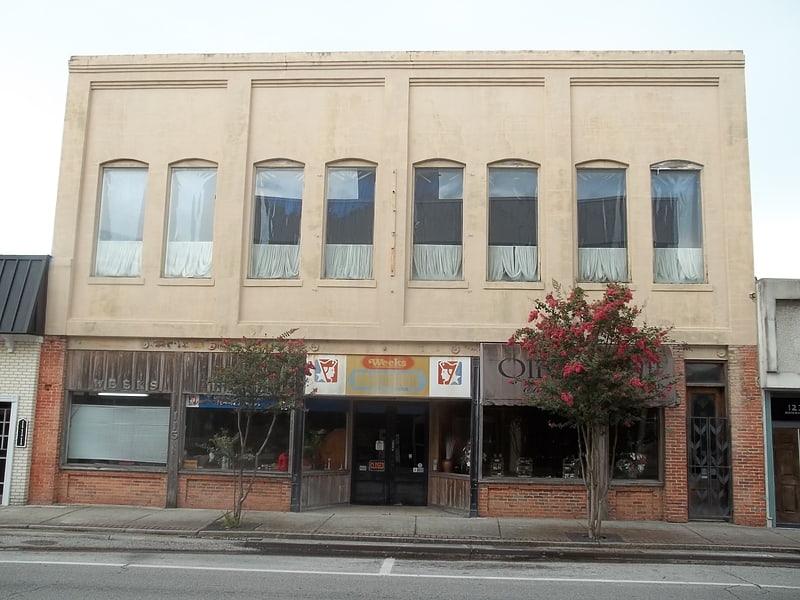
Weeks Hardware is a historic two-story brick 1913 hardware store building in Brooksville, Florida, located at 115 North Main.
The store was called Miro Hardware through the end of World War II, as a combination of the first names of Rosie and Mammie Weeks.
As of 2003, the store was the "oldest active business in town," according to the St. Petersburg Times, which added:
The reluctance to modernize is evident everywhere. The ceiling is high, made of elaborately patterned tin and in need of paint. The freight elevator in the back of the store is powered by hand.
A tall, darkly stained plywood case that holds bolts and screws in its dozens of drawers, was built, according to a little brass label on one corner, by A.R. Brown on May 7, 1901.
The founder's grandson, Joseph C. Weeks, worked in the store since childhood, and took over the business after returning from naval service and graduating from the University of Florida. Mr. Weeks, aged 82, was honored by the Brooksville City Council as "the 2009 Great Brooksvillian."
The building was owned by John Weeks, the first President of the First Federal Bank.
The historic J.M. Rogers Department Store built in 1912 is located across the street at 120 North Main.[4]
Croom Atv Park
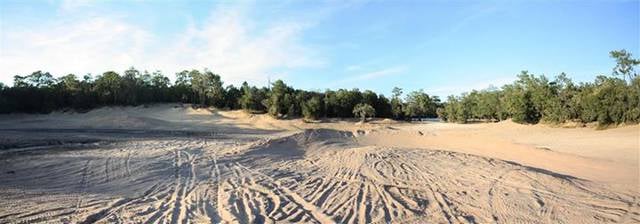
Gear rental, Outdoor activities, Park, Relax in park
Address: 6420 La Rose Rd, 34602-7513 Brooksville
First National Bank
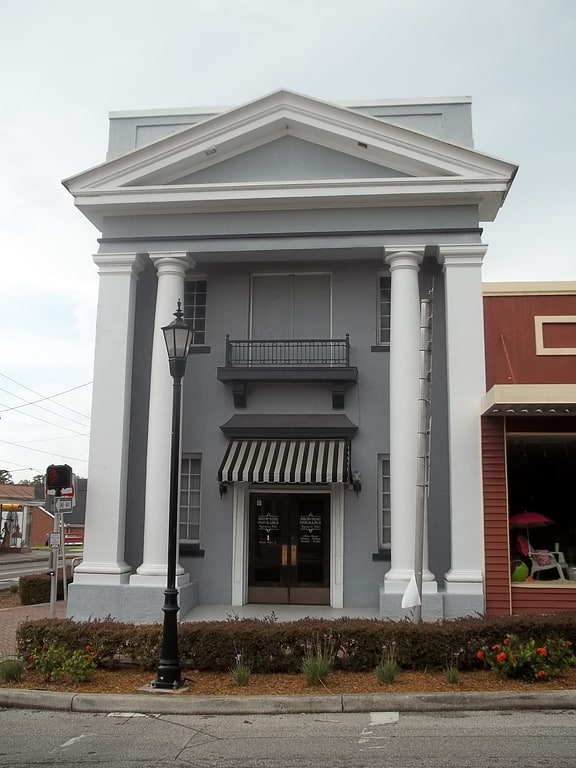
Building. First National Bank is a historic bank building in Brooksville, Florida. It was built in 1910 and is located at 1 Main Street. The 2-story brick building includes cast iron columns. The brick exterior was remodeled to give it a more Neoclassical appearance before 1926. The bank's first president, John Weeks, owned Weeks Hardware at 115 North Main. It is now used for the offices of Browning Insurance.[5]
Brooksville Railroad Depot Museum

Museum in Brooksville, Florida. The Brooksville 1885 Train Depot is one of three museums operated by the Hernando Historical Museum Association. The museum is located just south of downtown Brooksville, Florida on Russell Street. It was originally built by the Florida Southern Railway. The museum is dedicated to the railroad, and local history of Brooksville, Hernando County, and Florida.
In the 1880s America experienced a vast expanse of railroads. 75,000 miles of track were built. The state of Florida went from 500 miles of track to 2,489 miles of track in ten years.
Although roads have been important in providing the residents of Hernando with a means of transportation, it was not until the extension of the railroad to Brooksville, the commercial center of the county, that the area was given real opportunity to grow. Some railroads had been constructed in Florida before the Civil War, but they were short, isolated ones for the most part. No construction occurred during the war and extraordinarily little directly after it.
By 1880, Florida had but 550 miles of railroad concentrated north of Ocala. But during the next decade, Henry B. Plant in the western section of the state and Henry Flagler along the Atlantic coast built hundreds of miles of rail, extending the state's total to 2,566 miles.(2) For Floridians it was a dream come true, for thousands of square miles of back country were opened to the tourist and the real estate operators.
In the early 1880s the closest rail contact for Hernando county residents was at Wildwood, thirty miles to the northeast. Merchandise, produce, tourists and other items bound for Brooksville had to be transported there by wagon or stage over miles of dusty trails. Naturally, the people longed for the day when they would have a rail connection to the northern markets. (3)
Their hopes were raised when the Florida Southern Railroad was incorporated in 1879 for the purpose of striking a line from Central Florida to Charlotte Harbor (Port Charlotte). By 1881 it had pushed south to Gainesville and by 1885 it was at Pemberton Ferry, near Croom, just ten miles east of Brooksville. But the railroad had no plans to extend to Brooksville. (4)
Despite all the railroad activity, Brooksville and a great portion of the county was still lacking a railroad in 1885. Several local citizens then realized that they had better act fast, or Brooksville might remain in a state of virtual isolation.
Led by John Hale, four forward thinking business leaders (John Parsons, Christopher Keathly, John Hale, and W.S. Hancock) in the tiny town of Brooksville were eager to bring the railroad to their area. They formed the Brooksville Railroad Association and The Brooksville Telegraph Company and paid $20,000 to The Florida Southern Railroad to lay track twelve miles from the main line at Pemberton Ferry (Croom), to Brooksville (5). Bonds were sold and the Train Depot built in 1885.(6) The building still stands today. W.S. Hancock and Frank Saxon became officers of the telegraph company.
The Florida Southern Railroad was part the Plant railroad system. Henry Plant took his railroad to Tampa and beyond. He aided the development of Tampa as a major port.
In 1911 the Tampa Northern Railroad built an additional line north from Tampa to Brooksville. This gave Hernando County two daily passenger and freight schedules. Supplementing the Croom line were some small spur lines built from Brooksville to the Gulf of Mexico for logging camps with tracks running to the Fivay Mill in Pasco county, to Wiscon, Tooke Lake, and Centralia.(7)(8)
The Atlantic Coast Line bought the Florida Southern Railroad, and both Atlantic Coast Line and Tampa Northern serviced the Brooksville Train Depot. In 1911 the Tampa Northern Railroad built an additional line north from Tampa to Brooksville. This gave Hernando county two daily passenger and freight schedules. Supplementing the Croom line were some small spur lines built from Brooksville to the Gulf of Mexico for logging camps with tracks running to the Fivay Mill in Pasco county, to Wiscon, Tooke Lake, and Centralia.(7)(8)
In 1911 the Tampa Northern Railroad built an additional line north from Tampa to Brooksville. This gave Hernando county two daily passenger and freight schedules. Supplementing the Croom line were some small spur lines built from Brooksville to the Gulf of Mexico for logging camps with tracks running to the Fivay Mill in Pasco county, to Wiscon, Tooke Lake, and Centralia.(7)(8)
The Atlantic Coast Line bought the Florida Southern Railroad, and both Atlantic Coast Line and Tampa Northern serviced the Brooksville Train Depot.
After the Stock Market Crash in 1929, the railroad business plummeted. The spur to Tooke Lake and Centralia was closed, along with many other little used railroads. Trucks hauled freight and automobiles took the place of passenger train cars. Railroads fought back with piggyback flat cars that hauled the loaded trucks. Railroads offered special excursion train rides. School groups rode the train from Brooksville to Tampa for day long field trips. The railroad offered vacation packages to south Florida travelers from Hernando county.
These efforts were not successful and railroad use continued to decline. By the early 1960s the tracks at the Brooksville depot were gone. The depot was used as an administrative office a few more years before it closed completely.
In 1967 the two big railroads, Atlantic Coast Line and Seaboard Air Line merged and called the new railroad, Seaboard Coast Line (SCL).(9) In 1980 another merger of several railroads caused the formation of the CSX railroad, the largest railroad system in the United States (10). The vacant Brooksville Train Depot became the property of the CSX railroad.
In 1991 The Hernando Historical Museum Association purchased the 1885 Train Depot along with an acre and half of land from CSX for $12,600 (11) and restored the building. It is now a museum for visitors to enjoy.
The 1885 Train Depot Museum is made up of four parts.
The Office - Visitors enter in the office area, the front of the depot. This is where passengers came to buy their tickets, arrange for freight shipment, and send telegrams.
The Freight Room - The freight room houses train artifacts and displays depicting historical railroad events. Two HO model train exhibits delight the kids and adults alike. See original objects used by early settlers as they struggled to survive in the wilderness of Hernando County.
The Freight Dock - On the enclosed dock of the museum, ring the bell, sound the siren, or take your child's picture sitting in an original 1925 LaFrance Fire Engine; the first fire engine purchased by the city of Brooksville.
Also, on the dock are exhibits of farm equipment, industrial tools, and more railroad apparatus.
Cook \ Utility Box Car - Ron Daniel, while a Southwest Florida Water management employee, discovered an abandoned box car in a swampy area southeast of Brooksville in Sumter County. (12) It was hauled to the Brooksville Train Depot and restored. The work car was originally owned by Cummer Sons Cypress Lumber Company which cut timber in the area of the “Green Swamp”. The work car's normal function was to transport workers to the work site, but the box car could be used provide space for cooking and eating, sleeping, office work, and machinery operations.[6]
Frank Saxon House
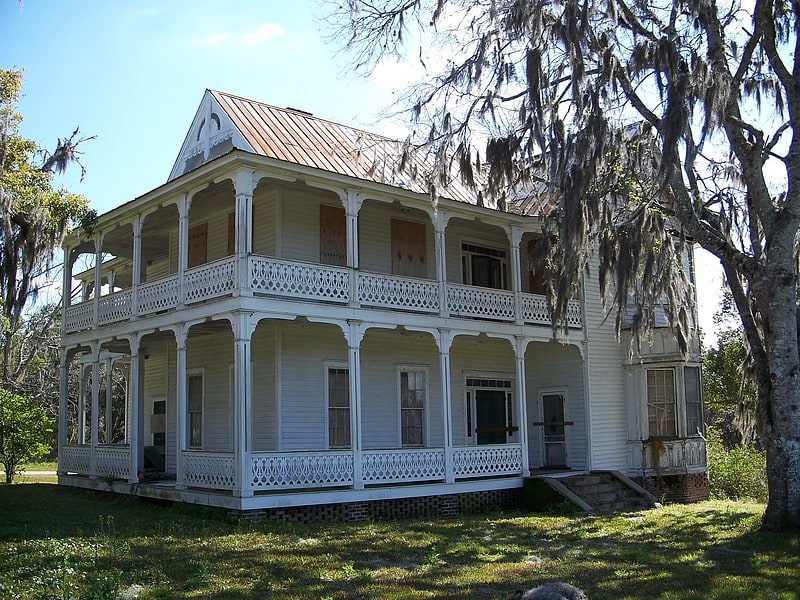
Historical place in Brooksville, Florida. The Frank Saxon House is a historic residence in Brooksville, Florida. The home was built by Frank Saxon in 1864 for his bride Tululu Hope, daughter of William Hope, one of the earliest settlers in the county. Mr. Saxon was a Civil War hero who was a member of the Hernando Wild Cats, a unit of the 3rd Regiment of the Confederate Army. After the war, Frank Saxon served as a member of the Florida Legislature representing Hernando County. The home sits on the top of a hill at 200 South Saxon Avenue. On November 5, 1998, it was added to the U.S. National Register of Historic Places.
The Frank Saxon House is one of the earliest examples of Frame Vernacular architecture with Queen Anne Revival influence in Hernando County. The house is in an extreme state of disrepair with windows, doors, and parts of the roof missing.[7]
Judge Willis Russell House

Building in Brooksville, Florida. The Judge Willis Russell House is a U.S. historic building in Brooksville, Florida. It is located at 201 South Main Street. On January 27, 1999, it was added to the U.S. National Register of Historic Places.[8]
T.S. Coogler House
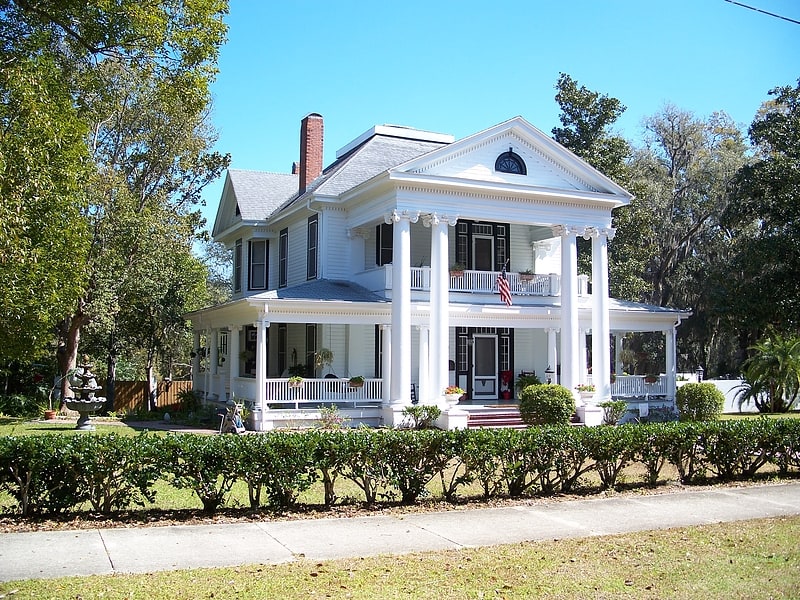
The T.S. Coogler House is a historic residence in Brooksville, Florida that belonged to pioneering educator and lawyer T.S. Coogler. The home later belonged to Judge Monroe Treiman. It is located at 133 South Brooksville Avenue. The Colonial Revival architecture house has two-story columns. It is part of the South Brooksville Avenue Historic District.
Brooksville's second courthouse may have been built with lumber from Coogler's mill.[9]
William Sherman Jennings House
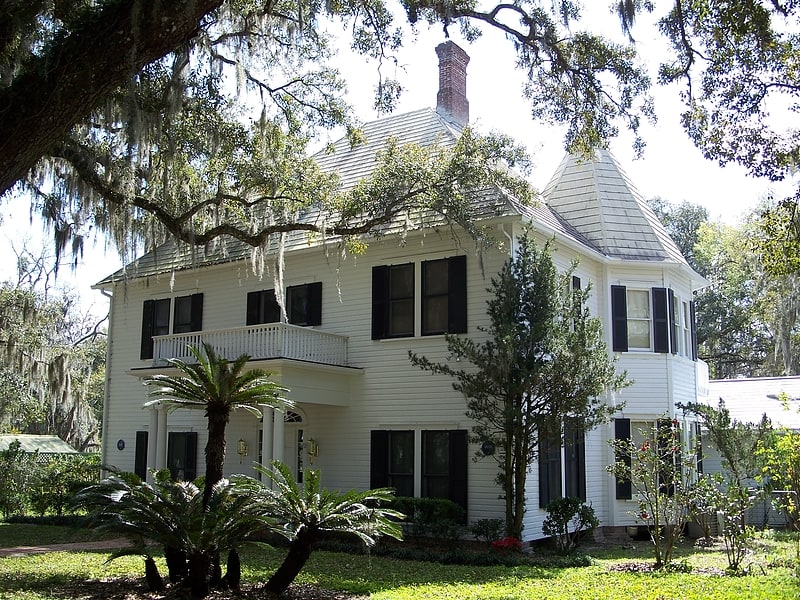
Historical place in Brooksville, Florida. The William Sherman Jennings House is a historic residence in Brooksville, Florida, United States. It dates to ca. 1890. Located at 48 Olive Street, it was added to the National Register of Historic Places on October 22, 1998.[10]